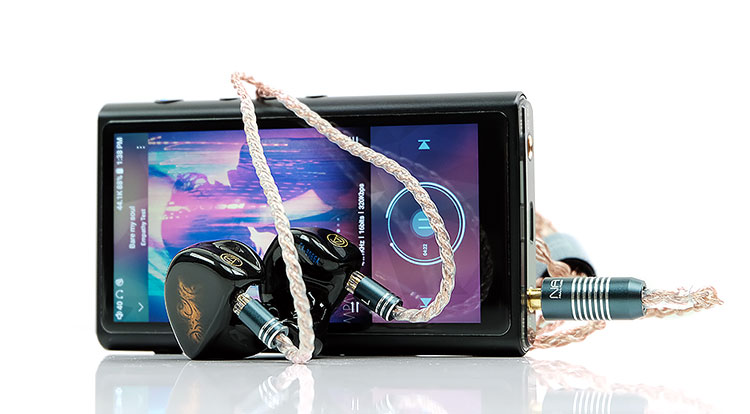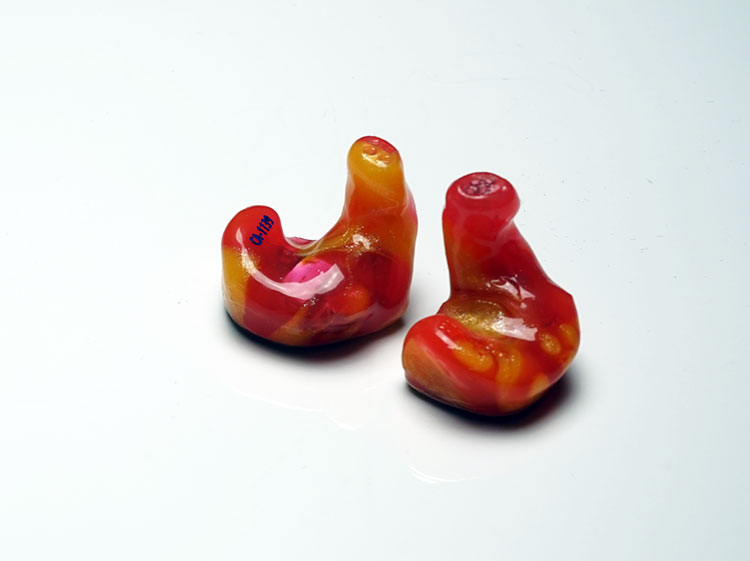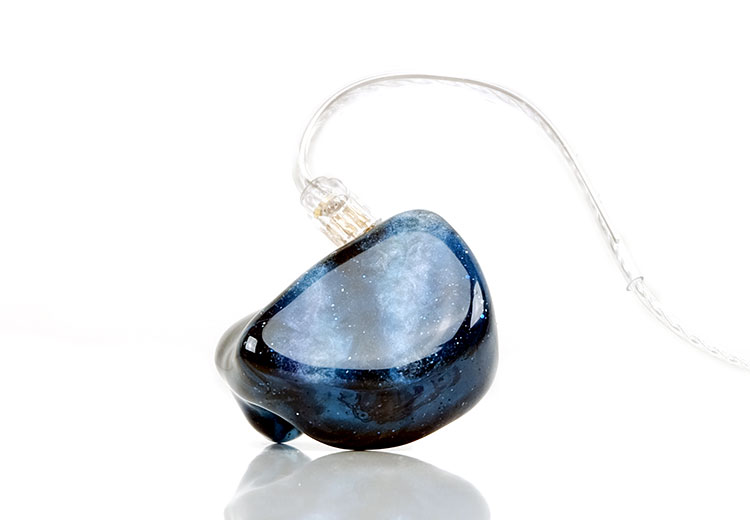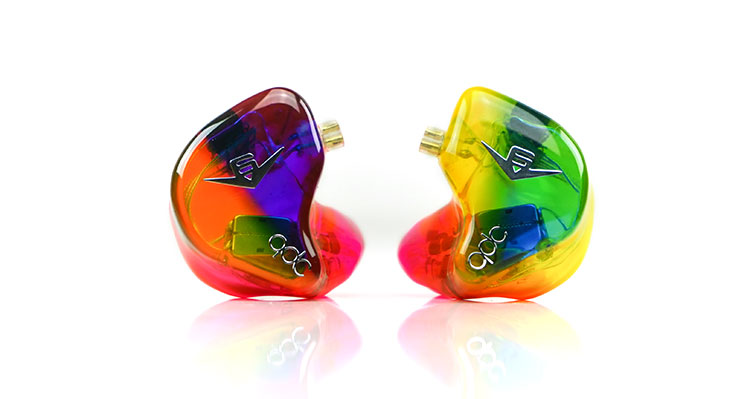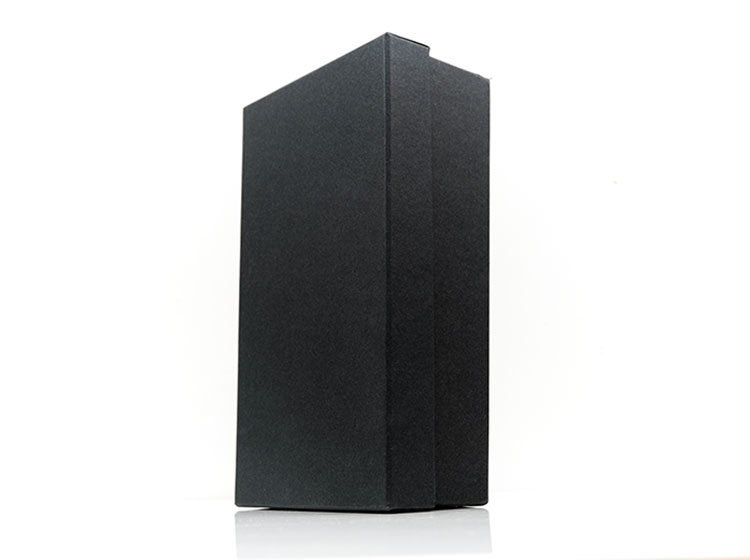Synergy
Efficiency
Like almost all of Custom Arts FIBAE creations, the FIBAE 7 stands out for its unusually low impedance rating at just 5.9Ω @1kHz (+-0.75 Ohm 10Hz-20kHz). You will not have issues driving the FIBAE 7 and logically, no issues with potential impedance mismatches with DAPs like the HiBy R6 and the Shanling M2s.
The SPL is 113dB @1kHz @0.1V which makes it more on the efficient side but not super-efficient levels compared to the Andromeda or Solaris from Campfire Audio.
Compared to their recently released FIBAE 4, the F7 is the easier to drive for current even though the FIBAE 4 is rated at 8.1Ω and 115dB. The same with the Harmony 8.2 also which is 15Ω and 118dB, the F7 is clearly the more sensitive of these 3 monitors.
Despite the enhanced sensitivity of the FIBAE 7, it does a good job of blocking out high noise floors and background hiss. With the likes of the FiiO M11 and their new flagship M15, the background noise was super low and in the case of the M15 a black background. I got the odd pop on the M11 when tracks started but nothing unusual.
Pairings
You have to go with something resolving and technically correct as source pairing with the FIBAE 7. That doesn’t mean neutral but rather a DAP or another source with good resolving capabilities and an above-average dynamic range.
Impedance
A few reasons for that. The first is the FIBAE technology itself. Output impedance will not skew the frequency bias of the F7 so it will stay mostly true to its core signature regardless of whether you plug it into the obvious 10Ω HiBy R6, or 4.4Ω Shanling M2s or more subtle 1.4-3Ω output of the M15.
Some of these high impedance ratings are too suppress noise but on sub-1Ω source pairings such as Cayin N6ii’s E01 motherboard, the sound floor and response are impeccable and accurate.
Technical Domain
Simply put, the FIBAE 7 will sound very consistent from source to source so that means the technical domain becomes very important. DAPs like the Lotoo PAW Gold Touch and the iBasso DX220 with AMP1 MKII really offered the most separation for me, followed by the FiiO M15.
Lotoo
Out of those three, the Lotoo was the punchiest with the best level of dynamic range and lowest noise floor using the FIBAE 7. The imaging was unreal from the PAW Gold Touch, especially left-to-right panning in recordings.
These often took me by surprise with the amount of speed and clarity skipping from one channel to another. The PAW 6000 was not that far behind its bigger brother either so it doesn’t have to be a flagship to get the best out of the F7.
Cayin
I have to give a special mention to the E01/Cayin N6ii pairing with the FIBAE 7 in Class AB mode. Whilst I do not think it has quite the same explosiveness as the Lotoo PAW Gold Touch pairing, this one focused more on delivering a very low noise floor. It also had a beautifully smooth almost analog-type tone with the F7.
What I also liked about this pairing also was the lack of overt coloration the F7 added to the sound of this source. The N6ii/E01 Class AB also played true to the balanced tuning of the F7 and teased out the mids really nicely without it sounding sharp or too lush. The Class A side I was less enamored with when paired with the F7. It just sounded too relaxed and that’s not how the F7 should sound.
Select Comparisons
Custom Art Harmony 8.2
€1,100
Technical
The Harmon 8,2 was launched some time ago but still their co-flagship now alongside the FIBAE 7. It does not have FIBAE technology so it is impedance skew is possible on high output rated DAP such as the HiBy R6.
However, it does have an 8-driver BA count as opposed to 7, (not that this matters much in 2020) and can be custom made in silicone as well as acrylic. The 7-driver FIBAE 7 can only be made in acrylic.
The configuration of each is different due to the additional driver inside the Harmony 8.2. The 8.2 uses a 4-way crossover in Single-Phase configuration with dual lows, dual full-range BA, dual mids, and dual tweeters.
The FIBAE 7 also uses a 4-way crossover but with a dual sub-low, single low-mid, dual mid-high, single proprietary high, and a single proprietary super high. Two of the drivers are also top-firing inside the FIBAE 7.
Design
Both beautiful but both very different. The lava silicone design of the Harmony 8.2 still resonates with me to this day as one of the more unique whereas the more noir black and orange Inca styling of the FIBAE 7 is modern yet understated. There is very little difference in sizing either between these two other than the length of the nozzle which is quite a bit longer on the Harmony 8.2.
The Null Audio Arete cable on the FIBAE 7 is a substantial upgrade for me on the plain “Plastic’s One’ 4-core of the Harmony 8.2. I have never used that cable, I would use the Arete.
Comfort, well if you try silicone you are in for a treat. They seal just as good as the FIBAE 7 but they are so soft and comfortable in your ear. It is hard to describe but I do wish more companies would try silicone.
Performance
Both of these monitors are fairly efficient and in fact, on paper, the Harmony 8.2 is more efficient at 17.5Ω and 118dB SPL compared to the 113dB SPL of the FIBAE 7. In reality, I needed less current by around 2-3dB on the F7 compared to the Harmony 8.2.
Neither of them displays any overt sensitivity to background hiss and are fairly easy to drive. However, the Harmony 8.2’s all-BA design and relatively low impedance make it more susceptible to impedance skew from high impedance outputs such as the HiBy R6.
Tuning
The big difference between these two monitors is the amount of air and openness in the mids and treble. The F7 treble tuning sounds more even to me with better presence and the mids certainly sound more expensive and holographic with better width. The Harmony 8.2 sounds narrower and slightly less resolving from the upper mids onwards.
Now for the low-end, the FIBAE 7 sounds the more potent of the two with a fuller low-end and slightly better mid-bass punch. I do think the Harmony 8.2 has a slightly more elevated sub-bass tuning but it’s not as full-sounding or as punchy in the midbass. You get a feel that the dynamic range of the Harmony 8.2 is just not quite as strong as the F7 so it sounds well-extended but still relatively ‘small’ in impact.
Vocals are further forward on the Harmony 8.2 but they sound a little thinner and with slightly less texture. Lower-mids are a shade drier with less presence on the Harmony 8.2. The F7 lower-mids sound more prominent.
Staging is very much in favor of the F7 with that holographic midrange and treble interplay. It just sounds more convincing for me both in terms of timbre and spatial cue placement. The Harmony 8.2 pulls it right into sub-bass and vocal focal points with less headroom so upper mids imaging is less prominent.
Honestly, you can tell just how more advanced the new drivers are in the F7 performance over the Harmony 8.2 as well as the more experienced hands in the CA tuning team.
Custom Art FIBAE 4
€725.00
Technical
The FIBAE 4 is their penultimate FIBAE custom monitor launched in early 2019 and priced a bit lower than the FIBAE 7. The FIBAE 4 consists of 4 BA top-firing BA drivers with a single low, single full-range, single proprietary high, and a single proprietary super high.
That is compared to the 7-driver config of the FIBAE 7 that uses dual sub-low, single low-mid, dual mid-high, single proprietary high, and a single proprietary super high. Two of the drivers are also top-firing inside the FIBAE 7.
The finish and designs we have here are quite different but you can have the same on both if you wish. The Galaxy blue of the FIBAE 4 is one of my favorite designs from Custom Art by the way.
Two differences to note are that neither of them are available in silicone and the FIBAE 7 does have the better Null Audio Arete cable option. The FIBAE 4 has a lower-grade4-wire 1.2m SPC stock cable in a silver jacket finish which I tend not to use.
Performance
The FIBAE 4 is rated at 8.1Ω and 115dB SPL. Much like the Harmony 8.2, the SPL is more sensitive to current than the FIBAE 7’s 5.9Ω and 113dB SPL rating. However, in real-world testing the FIBAE 7 felt much easier to drive and more sensitive to current from the likes of the Lotoo PAW Gold Touch and Cayin N6ii/E01 pairings.
Neither of them shows any vulnerability to commonly accepted higher noise floors from DAPs such as the FiiO M11 so hiss is not an issue with both the F4 and the F7. Impedance skew is not an issue either with both monitors due to them both deploying FIBAE technology. Both will sound accurate on the HiBy R6 as an example.
Tuning
The F4 is more v-shaped for me but has slightly less treble presence also. It creates a powerful and smooth presentation but darker comparatively speaking to the F7.
The F7 has less bass boost, less sub-bass power so combined with more treble presence and extension you will perceive an airier mids and treble performance. The timbre is more on the neutral side though for me it is not a dry sound at all. It is still relatively liquid in tone but the better treble tuning delivers some welcome clarity and balance, particularly with percussion.
The F4 has a more rounded tone with a bit more even harmonic bias from that low-end centric tuning. You hear more depth but slightly less midrange detail and separation. The upper mids are more forward so female vocals sound earthy and fulsome with less sibilance.
The F4 has the better staging depth but the F7 does better with imaging using that better midrange width and treble extension. I would keep the F4 for modern pop and EDM where I need plenty of power. However, for more complex music, rock and anything that requires good separation I would pick the F7.
qdc Anole V6
$1320
Technical
We reviewed and thoroughly enjoyed the Anole V6 earlier last year. This is priced marginally higher than the FIBAE 7 and is a 6-BA custom monitor.
The drivers are grouped into a 3-way crossover with 2 for the lows, 2 for the mids and 2 for the highs compared to the FIBAE 7 which is a 4-way with 2 lows, 3 for the mids and 2 for the highs. The Anole V6 also does not use top-firing BA drivers.
A key difference is the switchable tuning system that allows you to grab a few flavors in one monitor. The adjustable tuning of the V6 means you can choose between four distinct sound profiles for the V6 with a series of small switches on the side of each monitor.
Cables & Connectors
The Anole V6 also uses a reversed polarity cable connection system which is a pain in the neck. You can reverse the cable but it will sit awkward on your ears. Better to buy some adapters online which I use.
The cable is a non-branded 4-core silvering copper wire wrapped in a translucent PVC jacket around 1.2m in length. It performs ok for me but again, the Null Audio Arete on the FIBAE 7 looks better, handles as quiet and delivers a slightly better level of dynamic range.
Performance
The Anole V6’s rating is slightly variable as the switch system is impedance specific. So, it has a narrow range at 16-29Ω impedance and 106-109dB SPL.
Compared to the 5.9Ω and 113dB SPL of the FIBAE 7, however, it is the harder of the two to drive. On our tested DAPs, the Anole V6 was asking for around 2-3dB more in volume before we felt we had an approximate volume match.
Neither monitor displayed any particular issues with DAP noise floors. On our test DAPs such as the M11 both were silent, perhaps the Anole V6 even more so and both had lovely black backgrounds with the M15 and the N6ii/E01 Class AB amp. They are both fairly easy to drive for me.
Tuning
The stock Anole V6 has a bit more of a u-shaped classic musical tuning with a slightly greater sub-bass emphasis, a lighter leaner lower-mids timbre, and a brighter vocal presence. Treble is also a bit more elevated from 7-9k so the sparkle and presence are stronger on the Anole V6.
By comparison, the F7 is more rounded sounding, with a neutral midrange by comparison and more lower-mids body. Percussion is drier on the Anole V6 but it does have more presence and bite than the F7’s upper-mids/lower treble.
Bass is more linear on the F7 or slightly flatter with less of a lower-mids dip so the lower-mids timbre is fuller sounding despite the Anole V6’s stock tuning having a bit more sub-bass quantity.
Overall, the stock qdc Anole V6 sounds the cleaner, brighter and lighter tone of the two though with a slightly stronger sub-bass performance. The F7 is a bit more rounded, slightly richer with more lower-mids presence and a flatter bass signature.
Our Verdict
Ah, no doubt the FIBAE 7 is Custom Art’s best creation to date. It is still quite the CA house sound but it is more complex sounding now, more mature and refined. The magical sauce is how the F7 images so well for a soundstage that is not hugely expensive. It keeps things very clear but also very smooth and engaging at the same time.
I was also fascinated by going from the Harmony 8.2 to the FIBAE 7 and realizing how quickly drivers are evolving and becoming more complex at specific tasks. Those mid-firing drivers make a difference in the airiness of the signature despite it not having a huge treble extension. The dual-low drivers also sound more engaging even though the Harmony 8.2 might have the edge in sub-bass quantity.
Personally, I think this is an excellent to potentially great custom monitor. You can pair the FIBAE 7 with a wide variety of sources and it will sound credible with just about any genre outside of huge classical arena performances.
Custom Art FIBAE 7 Specifications
- Dual Sub-Low, single Low-Mid, dual Mid-High, single proprietary High, single proprietary Super High
- Two Top-Firing Balanced Armature Drivers
- Flat Impedance technology
- 113dB @1kHz @0.1V
- 5.9 Ohm @1kHz (+-0.75 Ohm 10Hz-20kHz)
- 10Hz-21000Hz (+-20dB into IEC 60318-4 coupler)
- Null Audio Arete OCC Copper cable
- Custom or universal fit


